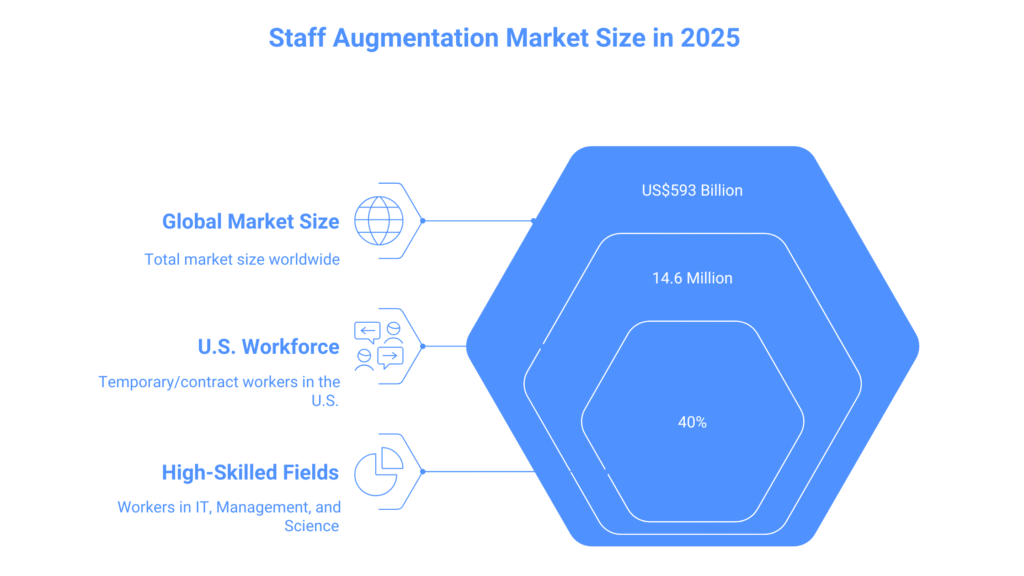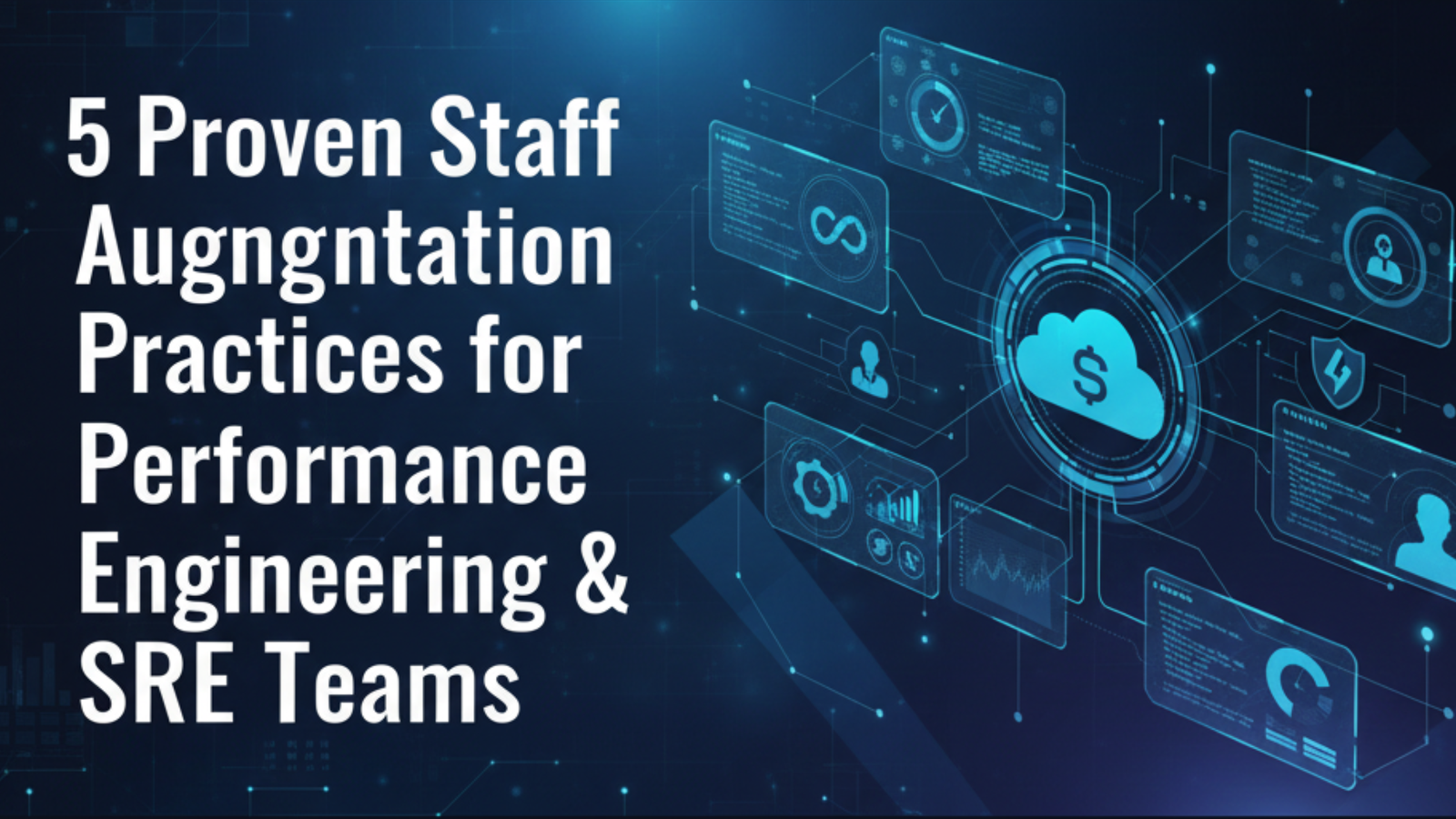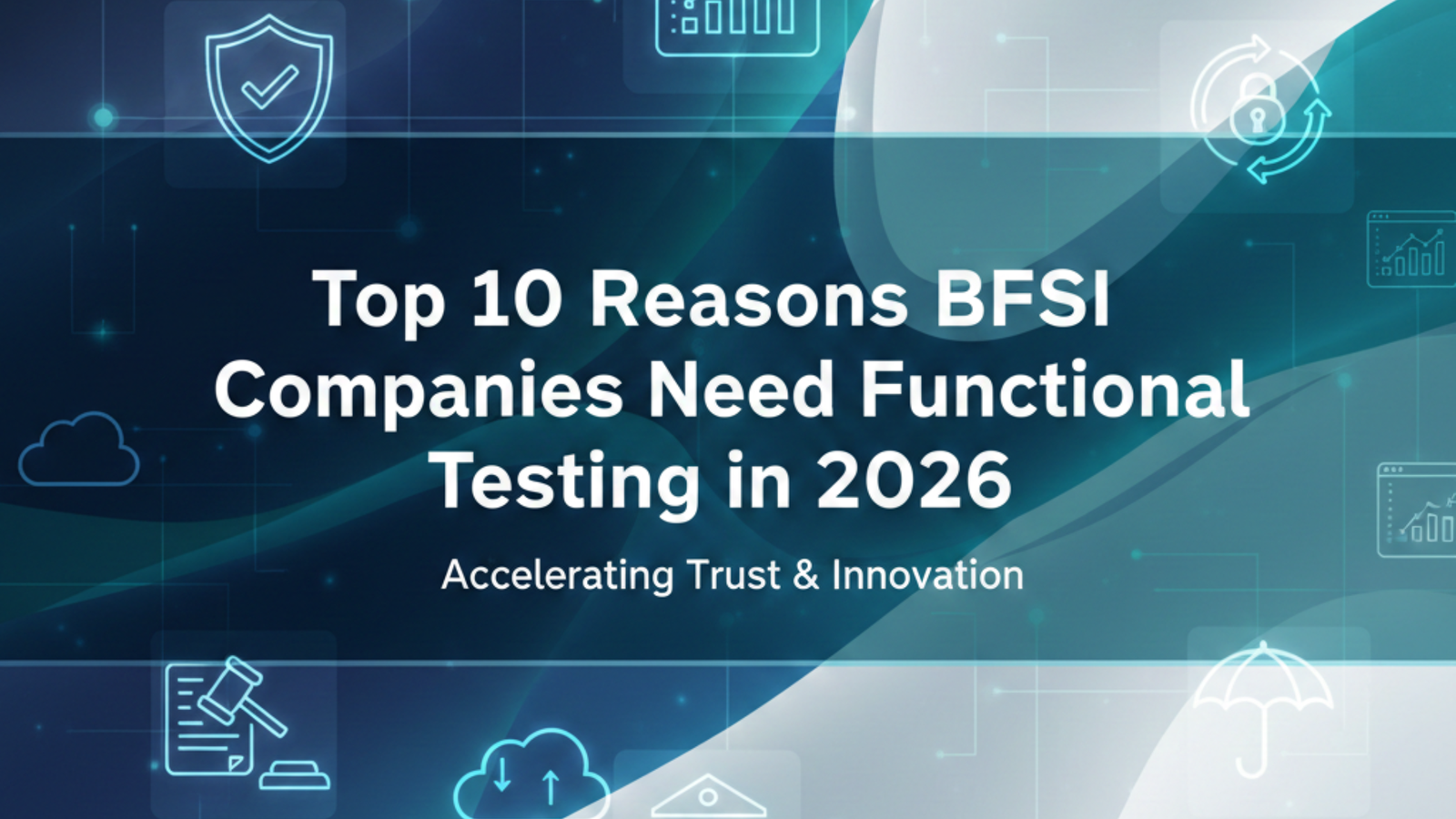Quick Summary :
Staff augmentation is an effective way to quickly grow your team by hiring skilled professionals from outsources, who can deliver results fast. It helps in filling the talent gap without the high costs and long timelnines of hiring full-time employees, enabling tech companies to innovate and stay competitive.
This guide covers what it is, when it works (and when not), detailed models, benefits & risks, how to select the right vendor or partner, real-world examples, and the latest trends (2025) you need to know.
What is Staff Augmentation?
In simplest terms, staff augmentation is a workforce strategy that allows organisations to temporarily or permanently add external professionals to their existing team to fill skill gaps, scale capacity, or accelerate delivery – while retaining management of the project, tools and processes.
Unlike full outsourcing (where you hand off the entire project) or permanent hiring (which may include overhead and long lead-time), staff augmentation falls somewhere in between: you augment your team, keep governance and control, and treat the new resources as part of your team for the scope of work.
Key differences:
| Model | Control by client | Ideal for | Vendor vs in-house roles |
|---|---|---|---|
| In-house hire | High | Core long-term capability | Full liability, HR cost |
| Full outsourcing / managed service | Low | Entire project outsourced | Vendor drives delivery end-to-end |
| Staff augmentation | Medium/High | Skill gap, ramp-up, short/medium term needs | Client manages, vendor supplies talent |
Why Staff Augmentation is Gaining Traction (2025 Update)
Here are updated market facts and drivers:
-
- The global staff-augmentation and contingent workforce market is estimated at US$593 billion in 2025.
-
- In the U.S., over 14.6 million temporary/contract workers are engaged, 40% in high-skilled fields like IT, management and science.
-
- Companies are facing persistent skills shortages, fast-moving digital transformation timelines and cost-pressure, all making augmentation a strategic lever.

Key drivers for your tech leadership team:
-
- Speed to market: When you lack the specific technology skills in-house (e.g., cloud-native DevOps, AI/ML, cybersecurity), augmentation enables faster ramp-up than hiring.
-
- Flexible capacity: Especially for project-based work, sprints, or variable demand (such as product launches).
-
- Control + integration: Unlike full outsourcing, you keep your workflows/tools (Jira, Slack, GitHub) and governance.
-
- Cost management: You avoid full-time hiring costs, benefits, long-term commitments; you can scale down when done.
Models & Types of Staff Augmentation
Understanding the models helps you choose what fits your situation. Below we refine and expand that list with further granularity.
By skill-level / role
-
- Commodity augmentation: Low-speciality roles, e.g., manual QA, data entry, simple front-end tasks.
-
- Skill-based augmentation: Specific technical skills needed, e.g., Angular developer, UX designer, cloud migration engineer.
-
- Specialist/Strategic augmentation: High-level roles with deep domain knowledge: e.g., AI/ML engineer, chief architect, cybersecurity lead.
By engagement model
-
- On-demand augmentation: You engage resources as needed, often short-term.
-
- Dedicated resource augmentation: One or more external professionals work exclusively on your project with your team, often for several months.
-
- Team augmentation: You add a full functional sub-team (developers, QA, PM) to plug into your product stream.
-
- Hybrid augmentation: A mix of above, possibly on-site + remote, nearshore + offshore, based on cost/skills/time-zone.
By location / delivery model
-
- On-site augmentation: External professionals work physically within your location.
-
- Nearshore remote augmentation: Professionals in nearby time-zones/cultures (e.g., Eastern Europe for Western Europe).
-
- Offshore remote augmentation: Professionals in distant time-zones (e.g., Asia for US/Europe) offering cost advantage.
Comparison table
| Model | Best for | Trade-offs |
|---|---|---|
| On-site | High-collaboration, sensitive projects | Higher cost, slower ramp-up |
| Nearshore remote | Balanced cost/time-zone/culture | Moderate cost, need remote-tools/process |
| Offshore remote | Cost efficient, large talent pool | Time-zone overlap, coordination risk |
| Dedicated resource | Longer term integration | You’re still managing external resource |
| On-demand | Short burst, flexible | Less tie-in, possible ramp-down risk |
When Should You Use Staff Augmentation (and When Not)
Ideal scenarios
-
- You have a short-to-medium term project that needs specialized skills not present internally.
-
- You have an existing in-house team and need extra capacity/specialty to meet deadlines.
-
- You want speed and flexibility, ramping up quickly and scaling down cleanly.
-
- You want to retain control over tools, processes, technology stack and delivery.
-
- You have defined governance, collaboration mechanisms and can integrate external resources as part of your team.
Scenarios where it may not be the best choice
-
- You require full ownership to outsource the entire project (then a managed-service model may fit better).
-
- You lack internal capability to manage remote/external resources, no established governance or PM.
-
- You want staff continuity and full loyalty/ownership of the people inside the business (then hiring full-time may make sense).
-
- The project requires a very long-term, core competency that you expect to internalise over time.
Decision-checklist
Before choosing augmentation, ask:
- What skills am I missing, and for how long?
- Do I have internal team/leadership to manage & integrate external resources?
- Is my project timeline short/medium or extremely long?
- What level of control do I want over tools/processes?
- What budget & cost-targets do I have?
- What time-zones / culture / communication channels will best suit integration?
What are the Key Benefits (and Risks)
Benefits
-
- Access to wider talent pool: You’re not limited by local geography. The entire world becomes your talent pool.
-
- Speed of hiring & ramp-up: You can onboard external professionals faster than full recruitment.
-
- Flexibility & scalability: You up-size or down-size as your project demands.
-
- Cost-effectiveness: Lower overhead vs permanent hiring; fewer long-term liabilities.
-
- Control and integration: Unlike full outsourcing, you maintain control of your workflow, tech stack and delivery.
-
- Speed to market: You meet deadlines, accelerate delivery because you fill skill/size gaps quickly.
Risks & mitigation
| Risk | Mitigation |
|---|---|
| Poor integration / team alignment | Clear onboarding, set roles/responsibilities, communicate culture. |
| Communication/time-zone issues | Use overlap windows, shared tools, regular check-ins. |
| Loss of control if vendor becomes “black-box” | Keep performance metrics, transparency, regular reviews. |
| Cultural/motivation mismatch | Choose vetted professionals, build inclusive team culture. |
| Dependency & knowledge loss when contract ends | Document knowledge, cross-train in-house staff, plan hand-over. |
| Hidden costs (management, communication overhead) | Factor in governance cost, provide dedicated bridging roles. |
How to Implement a Staff Augmentation Program Successfully
Here’s a practical, step-by-step approach for managers/CTOs:
Define your staffing need
-
- Audit your current team: what skills are missing? What roles will you need in next 3-12 months?
-
- Determine duration: short-term (3-6 mths) vs long-term (12-24 mths) vs ongoing capacity.
-
- Clarify the function of the augmented resources: will they work independently, or tightly integrated with your core team?
Choose the right engagement model & vendor
-
- Match model to need: on-demand vs dedicated vs team; on-site vs remote.
-
- Evaluate vendor or platform: talent-vetting process, time-zone overlap, cultural fit, prior domain experience.
-
- Ask for case-studies, references, retention metrics (how well the vendor keeps talent) and ramp-up time.
-
- Clarify contracts: hourly vs fixed vs retainers; exit scenarios; knowledge-transfer; IP and confidentiality.
Onboard & integrate effectively
-
- Treat external staff as part of your team: include them in stand-ups, sprint reviews, code reviews, retrospectives.
-
- Set clear roles, responsibilities, KPIs: who reports to whom, deliverables, dependencies.
-
- Provide the tools and access: Slack, Jira, Confluence, secure repos, documentation.
-
- Create communication rhythm: daily stand-ups, weekly syncs, bi-monthly face-to-face if possible (or virtual).
Monitor performance & manage the engagement
-
- Use KPIs: productivity (story points, delivered features), quality (bugs, re-work), collaboration (feedback), time to market.
-
- Maintain transparency: dashboards, progress logs, risk logs.
-
- Re-assess regularly: continue if value is proven; scale down if not required; plan for hand-over/leaving.
Plan for scale-out and off-ramp
-
- Define exit strategy: when engagement ends, how knowledge is handed-over, documentation shared, resources moved out.
-
- Cross-train internal staff: avoid single-point dependency on augmented resource.
-
- Evaluate conversion possibility: sometimes you may convert external resource into full-time if value is high.
Cultural & team-fit considerations
-
- Set expectations about culture, working hours, responsiveness, code-standards.
-
- Use remote-team best practices: clear communication norms, inclusive meetings (consider time-zones), shared virtual spaces.
- Build camaraderie: virtual coffee chats, recognition, inclusion.
Latest Trends & Future-Facing Insights (2025)
-
- AI-enabled talent matching: Augmentation platforms increasingly use AI/ML to match candidates not only by technical skill but by team culture fit, time-zone alignment, speaking proficiency, and personality dimension.
-
- Hybrid models (augmentation + outsourcing): Some firms blend augmentation with managed service boxes. For e.g., you have a dedicated team but the vendor provides team lead and knowledge transfer to shift gradually to in-house.
-
- Focus on long-term partnerships, not one-off contracts: Instead of short bursts, companies build “augmented pipelines” of trusted talent they can tap repeatedly, this improves ramp-up time.
-
- Rapid upskilling & micro-specialities: With fast-moving tech (cloud-native, DevSecOps, edge computing, low-code/no-code), you’ll find augmentation used for very specific niche roles (e.g., Kubernetes security engineer, low-code integration specialist).
-
- Remote culture maturity: With the rise of permanent remote/hybrid teams, the integration challenge is less about geography and more about culture. Augmented teams are expected to plug into culture from day one.
-
- On-demand “just-in-time” augmentation: As projects move to sprint-based, businesses are hiring talent weekly/monthly rather than for fixed long-term durations, this agility gives competitive edge.
-
- Increased compliance & security focus: With data privacy (GDPR, CCPA), supply-chain risk and cyber-risk, augmented engagements require vendors with certified security practices, NDA workflows, and audit transparency.
Selecting the Right Staff Augmentation Vendor or Partner
Here are actionable criteria you should evaluate when choosing a partner:
- Talent Pool Depth & Vetting – How many professionals are available, how are they screened (technical test, personality/culture fit).
- Time to Ramp-Up – What’s the average time to deliver vetted CVs, onboard them, get them productive.
- Cultural / Time-Zone Fit – Are professionals in appropriate time zones, do they speak the required language, can they integrate into your rhythm.
- Retention & Knowledge-Transfer – How long do augmented resources stay, how do you ensure knowledge capture and hand-over.
- Governance, Transparency & Reporting – Are there dashboards, KPIs, client-visibility, escalation paths.
- Security & Compliance – NDA, IP ownership, security certifications, data-handling practices.
- Flexibility of Contract – Ability to scale up/down, convert to full-time, exit clause, cost structure (hourly vs fixed vs retainer).
- Domain / Technology Expertise – Beyond generic engineering skills—do they have experience in your domain (fintech, healthcare, manufacturing), relevant tech stack (cloud, AI, Kubernetes).
- Client References / Case-Studies – Ask for previous clients with similar needs.
- Cultural Fit & Integration Mechanism – How do they help your in-house team integrate remote talent, do they provide onboarding support, team-leads, bridging resources.
Summary & Key Takeaways
-
- Staff augmentation is a strategic way to scale your team quickly, fill skill-gaps, keep control of project delivery, and manage cost.
-
- The model is especially effective when you already have an in-house team, clear governance, and need flexibility for short-to-medium term engagements.
-
- There are different models (by skill, location, engagement type) and selecting the right one is crucial.
-
- To succeed you need clear role definitions, onboarding/integration plan, metrics, transparency and exit strategy.
-
- Emerging trends for 2025 (AI-driven matching, micro-specialised talent, hybrid models) will shape the way augmentation is done.
-
- With the right vendor/partner you can turn staff augmentation from a stop-gap into a strategic advantage, building a “talent pipeline” and faster delivery engine.
Frequently Asked Questions (FAQs)
Augmentation in the workplace refers to enhancing an organization’s workforce by adding skilled professionals on a temporary or project-based basis. Instead of hiring full-time employees, companies “augment” their team with external talent to fill skill gaps, manage peak workloads, or accelerate project timelines.
Staff augmentation provides skilled professionals who work under your management and integrate with your in-house team.
Consulting, on the other hand, involves hiring an external firm to deliver expertise, strategy, and solutions, often with its own team managing the work.
In short, augmentation adds people; consulting delivers outcomes.
Job augmentation means expanding an employee’s responsibilities or tasks to make their role more engaging and productive. This is different from staff augmentation, which involves adding external talent. Job augmentation focuses on improving an existing employee’s role, often to boost satisfaction and performance.
With staff augmentation, businesses hire external specialists who work alongside their internal team and remain under their direct supervision.
With outsourcing, an entire function or project is handed over to a third-party company that manages everything from planning to execution.
Staff augmentation = add people.
Outsourcing = hand off the work.
A staff augmentation role is a temporary position filled by an external professional hired to support a company’s current team. These roles are project-specific and can include developers, designers, project managers, analysts, and other specialists required to meet short-term needs.
Staff augmentation in IT is when companies hire external tech professionals such as software developers, QA engineers, DevOps specialists, or UI/UX designers to support internal teams. It is widely used to scale quickly, address skill shortages, and speed up product development without long-term hiring commitments.
A common example is when a company needs extra developers to meet a product launch deadline and brings in three contracted engineers for six months. These developers work directly with the internal team, attend daily standups, and follow the company’s processes just like regular employees, but without long-term commitments.
Job augmentation refers to improving an existing employee’s job by adding meaningful tasks or responsibilities. The goal is to enhance engagement, increase productivity, and develop new skills. It’s an internal HR practice, not an external hiring model.
Staff augmentation companies in India offer global businesses access to highly skilled professionals, particularly in IT, engineering, finance, and customer support at cost-effective rates.
Here are the top 5 staff augmentation companies:
- Avekshaa Technology
- Bacancy Technology
- Plaxonic Technologies
- Q3 Technologies
- Toptal
The staff augmentation model is a hiring approach where a company supplements its existing team with external talent for short-term or long-term projects. The augmented staff works under the company’s direction, providing flexibility, scalability, and access to niche expertise without the cost of full-time hiring.


